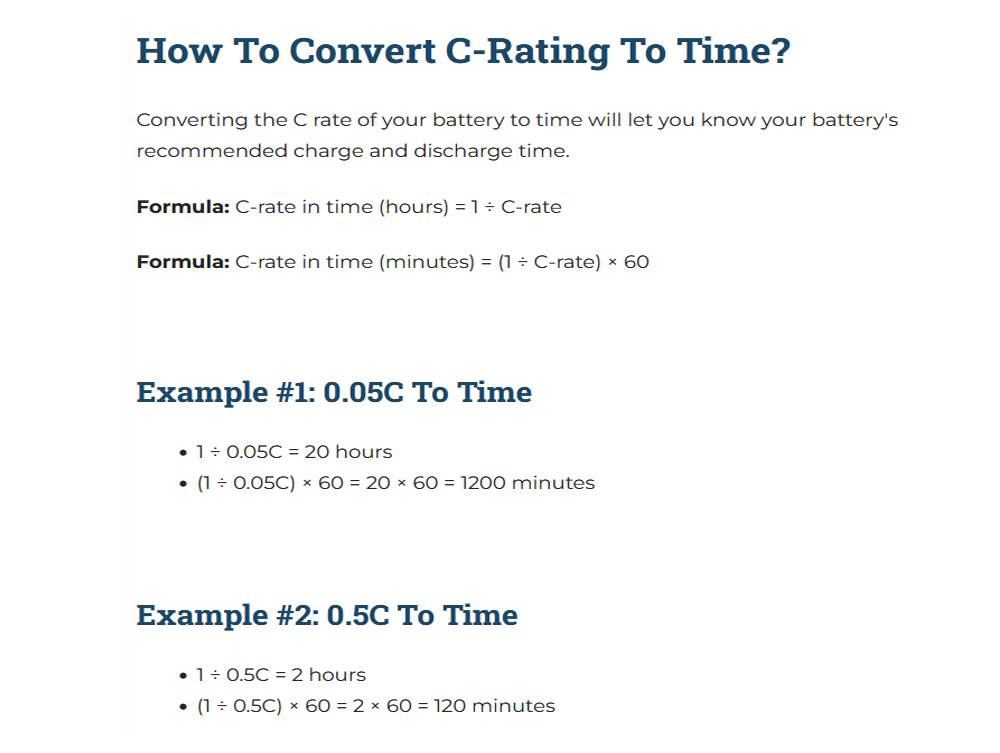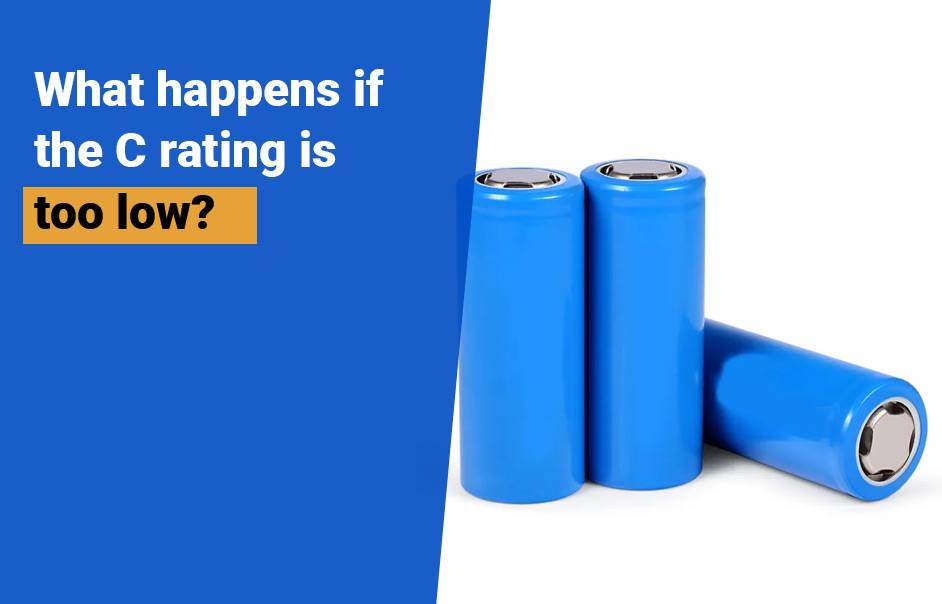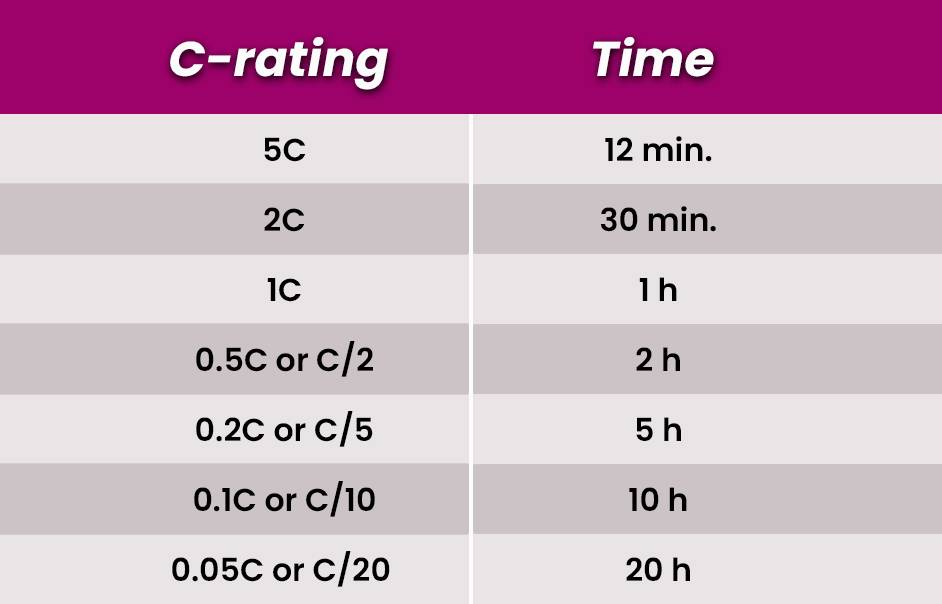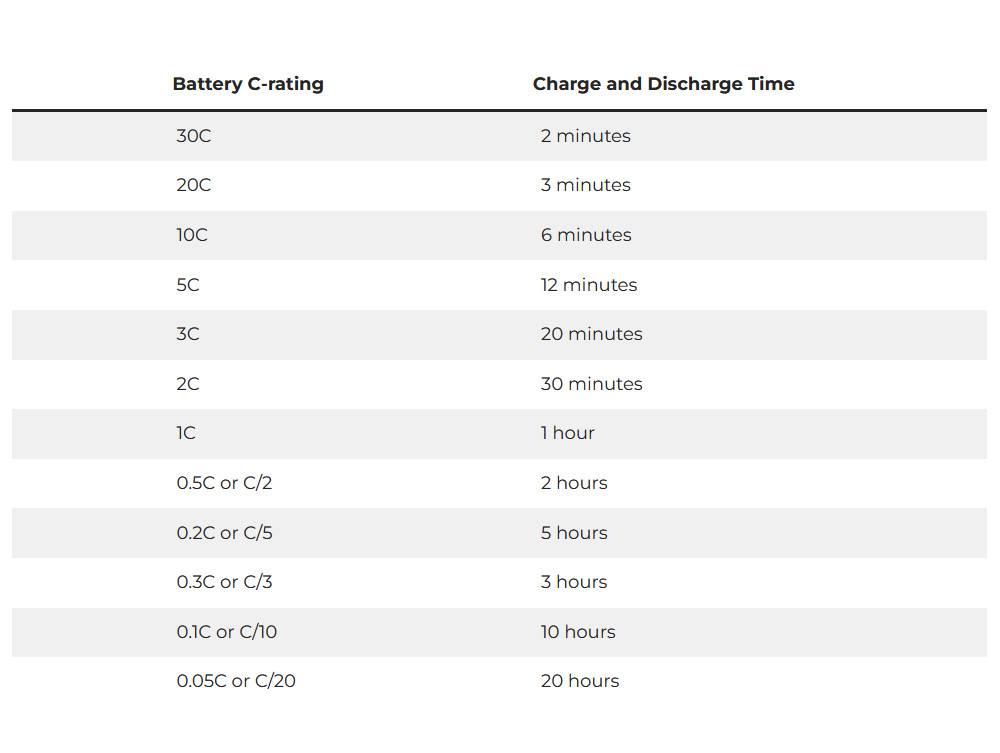The C rating of a battery indicates its discharge rate capability relative to its capacity. It’s calculated by multiplying the discharge rate (in C) by the battery’s capacity (in Ah). Whether you’re an electronics enthusiast or making informed battery choices, the article unveils the significance of C rating across various applications.
What is Battery C Rating and Why is it Important?
The C Rating of a battery is the measurement of current at which it is charged and discharged. It is expressed as a multiple of the battery’s capacity. For example, a C Rating of 1C means the battery can provide a current equal to its capacity for one hour.
The C Rating of a battery is important because it determines the rate at which the battery can be charged or discharged. A higher C Rating indicates faster charging and discharging capabilities, allowing for more efficient power delivery.
- What is C Rating? It’s a battery’s discharge rate capability, showing how much current it can provide relative to its capacity.
- Why is it Important? Determines if a battery suits your device. Using a low C rating for a power-hungry device might lead to performance issues or overheating.
- Calculating C Rating: Consider your device’s max current draw and potential bursts in power demand. Choose a matching C rating for optimal performance and longevity.
Choosing the right C rating is crucial for smooth device operation and protecting your investment in rechargeable batteries. Next time you shop, check those labels carefully to find the perfect match!
How to Calculate Battery C Rating
The C Rating of a battery is calculated by dividing the charge or discharge current by the battery’s rated capacity. For example, a 2,500 mAh battery charged with a current of 5,000 mA would have a C Rating of 2C.
Calculate a battery’s C Rating to understand its performance for your application. Follow these steps:
- Key Factors: Identify the battery’s capacity in ampere-hours (Ah) and maximum discharge current in amperes (A).
- Formula: Divide maximum discharge current by battery capacity. For example, with a 1000mAh capacity and 10A discharge, the C Rating is 10C.
- Consistent Units: Ensure units (mAh or Ah) are consistent for both factors. Convert if needed.
Understanding C Ratings helps assess battery suitability. Higher C Ratings deliver more power quickly but may have lower overall capacity, while lower C Ratings offer higher capacities but limited power delivery.
Factors That Affect Battery C Rating
The C Rating of a battery can be influenced by factors such as temperature, internal resistance, age, and battery chemistry. These factors can impact the battery’s discharge time and efficiency.

Factors influencing battery C rating include temperature, internal resistance, age, and chemistry:
- Temperature Impact: Extreme temperatures affect discharge rate and capacity. Hot or cold conditions can alter battery performance significantly.
- Internal Resistance: Higher internal resistance lowers the effective C rating. Batteries with more internal resistance may struggle to deliver full rated current under heavy loads.
- Age and Condition: As batteries age, capacity decreases, reducing their ability to deliver high currents. Regular checks and maintenance are crucial for optimal performance.
- Chemistry Differences: Various chemistries have different C ratings. For instance, lithium-polymer batteries often have higher C ratings than nickel-metal hydride batteries due to better discharge capabilities.
Consider how you use and charge batteries to maintain overall health. Frequent deep discharges or improper charging can decrease capacity and lower effective C ratings.
Understanding these factors empowers users to make informed decisions, ensuring optimal battery performance and longevity for specific applications.
Common Misconceptions About Battery C Rating
Clarifying misconceptions about battery C ratings is vital for effective use and optimal performance:

- Higher C Rating Doesn’t Guarantee Better Performance: While a higher C rating may suggest more current delivery, factors like voltage sag, internal resistance, and temperature influence overall performance.
- C Rating Doesn’t Determine Battery Lifespan: Runtime is determined by battery capacity, not C rating. High C rating doesn’t guarantee longer lifespan or durability; factors like cycle life and build quality matter.
- Exceeding C Rating Can Cause Issues: Surpassing recommended C rating for a device may stress both device and battery, potentially decreasing efficiency and causing damage.
- Not All Similar Capacity Batteries Have Identical C Ratings: Different brands or models may have varied testing methods and standards for determining C rating, making assumptions about uniformity inaccurate.
Understanding these realities helps users make informed decisions when selecting batteries, considering specific requirements beyond advertised numbers. Dispelling myths ensures suitable power sources for devices, prioritizing safety and longevity.
Importance of Understanding Battery C Rating in Different Applications
Unlock the power of battery C rating for different applications:
- Essential in High Discharge Apps: For racing drones or power tools, a higher C rating is vital. It ensures the battery can meet power demands without overheating or damage.
- Adapt to Low-Power Needs: LED lights or small electronics can do well with a lower C rating, avoiding unnecessary costs and weight. High C ratings are excessive for these low-current devices.
- Factors Influencing C Rating: Understand cell chemistry, internal resistance, and temperature impact on how effectively a battery delivers its rated current. These factors shape performance in various applications.
Misconceptions about C ratings are common. Higher capacity doesn’t always mean a higher C rating; capacity refers to stored energy, while C rating indicates current delivery ability.
Comprehending and calculating C ratings based on specific needs empowers users to optimize performance while avoiding unnecessary costs or potential damage from mismatched voltage specifications. Choose batteries wisely for the best results!
How to Find The C Rating Of My Battery?
The C rating of a battery can indeed vary depending on its chemistry, and it’s usually indicated on the battery label or datasheet. Different battery chemistries, such as lithium iron phosphate (LiFePO4), NCM (Nickel Cobalt Manganese), and lead-acid, have different typical discharge rates.
- Lithium iron phosphate batteries typically have a discharge rate of around 1C.
- NCM batteries often have higher discharge rates, around 3C.
- Lead-acid batteries typically have lower discharge rates, often around 0.05C or sometimes indicated by a 20-hour rate.
If you’re unable to find the C rating on the label or datasheet, contacting the battery manufacturer for clarification is recommended.
FAQs
How do I choose my battery C rating?
To choose the appropriate battery C Rating, consider factors such as the required maximum current and the battery’s capacity. Select a C Rating that can safely handle the desired current for your specific application.
What is the current limit of a C battery?
The current limit of a C battery can vary depending on factors such as battery chemistry and discharge conditions. Alkaline C batteries can have a storage capacity of up to 8000 mAh, while rechargeable NiMH C batteries can hold up to 6000 mAh.
What is the discharge rate of a lithium battery in C?
The discharge rate of a lithium battery, expressed in C-rate, refers to the rate at which the battery can deliver its rated capacity. For example, a 1C discharge rate means the battery can deliver its capacity in one hour.
Is there a limit to battery capacity?
The capacity of a battery is influenced by factors such as battery chemistry and design. While there are theoretical limits to battery capacity based on energy density, practical limitations exist due to factors like size, weight, and safety considerations.
What happens if the C rating is too low?
If the C rating of a battery is too low, it may not be able to provide the necessary current for specific applications. This can lead to reduced performance, voltage drop, and potential damage to the battery or connected devices.

How does the C rate impact capacity?
At higher C rates, some energy can be lost and converted into heat, resulting in a decrease in battery capacity by 5% or more.
Implications of Different C Rates for Charging and Discharging
Using different C rates for charging and discharging batteries can impact battery performance. Higher C rates may produce lower capacity readings during discharge, while lower C rates can result in longer charging times.
What are some common battery chemistries and their associated C Rates?
Some common battery chemistries and their associated C rates include Lithium Nickel Manganese Cobalt Oxide (LiNiMnCoO2) with a C-rate range of 1-5C, Lithium Iron Phosphate (LiFePO4) with a C-rate typically ranging from 0.5C to 2C, and Nickel-Metal Hydride (NiMH) with a C-rate typically around 0.5C.
Calculating Battery Output Based on C Rating
To calculate a battery’s output current, power, and energy based on its C Rating, use the formulas: Output Current = C Rating * Capacity, Output Power = Output Current * Voltage, and Output Energy = Output Power * Time.

What are some applications that require high C Rates for batteries?
Applications that require high C Rates for batteries include RC models, drones, robotics, and vehicle jump starters. These applications require batteries capable of delivering powerful energy bursts in a short period of time.
What are the limitations of lithium battery C-rate?
The limitations of lithium battery C-rate include thermal heating and mass transfer limitations. High C-rate charging can lead to excessive heat generation due to internal resistance, while mass transfer limitations can affect the efficiency of charge and discharge processes.

Significance of Li-ion Energy Cell Protection Circuit
The protection circuit in Li-ion Energy Cells is significant in controlling discharge rates. It prevents the cells from discharging above a certain rate, typically around 1C, to ensure safe operation and protect the battery from damage.
Battery Capacity and Discharge Rate
The energy capacity of a battery can vary with the discharge rate and internal resistance. As the internal resistance of the battery increases, the voltage drop will be more pronounced, which means that the battery’s usable capacity will be reduced.
What are some typical discharge times at various C-rates for a 1Ah battery?
When examining discharge times at different C-rates for a 1Ah battery, it is essential to understand the relationship between the C-rate and the duration of discharge. A C-rate represents the rate at which a battery’s capacity is discharged or charged relative to its nominal capacity in one hour. For instance, a C-rate of 1C indicates a discharge that would deplete the battery’s full capacity in one hour.
In the context of a 1Ah battery, various C-rates correspond to different discharge times. For example, a C/5 or 0.2C rate signifies a discharge that would take 5 hours to deplete the battery’s capacity fully. Conversely, a 1C rate is equivalent to a one-hour discharge, while a 0.5C or C/2 rate represents a two-hour discharge duration. Moreover, for a 1Ah battery, typical discharge times at different C-rates can be summarized as follows:
– 5C rate: 12 minutes
– 2C rate: 30 minutes
– 1C rate: 1 hour
– 0.5C rate: 2 hours
– 0.2C rate: 5 hours
– 0.1C rate: 10 hours
– 0.05C rate: 20 hours
These discharge times provide insights into how the battery’s capacity is utilized at varying rates, influencing the overall performance and longevity of the battery during operation.
How are battery capacities measured using a battery analyzer?
To measure battery capacities using a battery analyzer, discharge the battery through a load and measure the current and time. The capacity is usually expressed in milliamp-hours (mAh) or watt-hours (Wh).
Battery Capacity Rating Methods
To obtain capacity readings, manufacturers commonly rate alkaline and lead-acid batteries at a very low 0.05C or a 20-hour discharge. This slow discharge rate allows for a reasonably accurate measurement of the battery’s capacity.
Adjusting Battery Capacity Readings at Varying C Rates
To adjust for discrepancies in battery capacity readings when discharged at different C rates, manufacturers provide capacity offsets. These offsets account for the differences in capacity observed when a battery is discharged at a higher C rate than specified.


